Project BudBurst
Air Date: Week of February 15, 2008
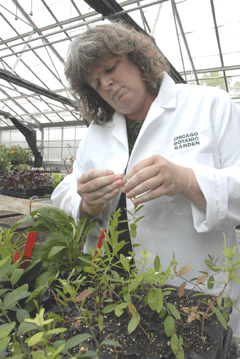
Dr. Kay Havens of the Chicago Botanic Garden. Havens leads a team of over 200 scientists, research associates, graduate and undergraduate students who are making vital discoveries about plant survival, habitat destruction, invasive species and restoration. (Photo: Courtesy of Chicago Botanic Garden)
Volunteers can now help scientists track climate change by going online and entering information about when they see local plants bloom. Host Steve Curwood speaks with Dr. Kay Havens, director of Plant Science and Conservation at the Chicago Botanic Garden, about the project.
Transcript
CURWOOD: You may be more than ready for this winter to end, and while you look for signs of spring, you might want to lend science a hand. What you do is join Project Budburst, linked to the University Corporation for Atmospheric Research. Their website will allow you to log on and document the emergence of flowers and foliage to track climate change. Among the creators of the website is Dr. Kay Havens, director of plant science and conservation at the Chicago Botanic Garden. She joins us now from her office in Glencoe, IL.
Welcome to Living on Earth, Dr. Havens.
HAVENS: Thank you very much.
CURWOOD: So what can blooming flowers tell us about climate change?
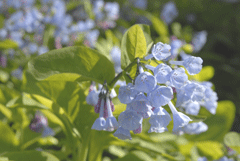
Mertensia virginica (Virginia bluebells). Kay Havens recorded the date the bluebells flowered in her own garden. (Courtesy of Chicago Botanic Garden)
CURWOOD: So, what prompted you to come up with this website - Project BudBurst - where just about anyone can log in and document when the flowers bloom in their yard or anywhere they care to look I would gather.
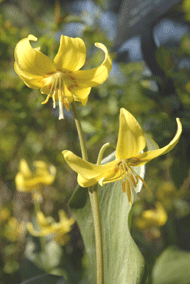
A Trout Lily. (Courtesy of Chicago Botanic Garden)
CURWOOD: And an opportunity to become a phenologist, right?
HAVENS: That’s correct!
CURWOOD: So, how does this website work - I mean how could one of our listeners get involved in this?
HAVENS: You can sign in and become a BudBurst member and record your location. And after that you can look at species guides, decide which species you want to monitor, watch them in your own yard and then log in and tell us the day that they first come into bloom, or you see the first leaf or you see the first fruit.
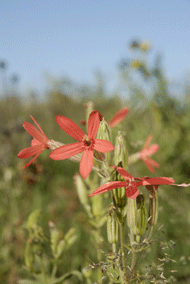
Silene regia (Royal catchfly). Project BudBurst hopes to gather data on flowers like the Royal Catchfly. (Courtesy of Chicago Botanic Garden)
HAVENS: Well, we at the Garden and a number of other scientists are modeling how plants will respond to climate change. So we want to know: what climate envelopes do plant species survive in, as the climate changes where might they need to migrate to? And so getting data on bloom time is very valuable to use in these modeling efforts.
CURWOOD: Now, to what extent do you have schools involved in this?
HAVENS: We have a lot of school groups who participate. In our pilot year we had over 900 observations submitted and of those, nearly two thirds were done by children under 12.
CURWOOD: So this is not just citizen science, this is kid science!
HAVENS: This is kid science! Yeah, and we’re thrilled to be really engaging kids in collecting data that is important and useful.
CURWOOD: Now I imagine you’re too busy at this Chicago Botanic Garden to have your own garden.
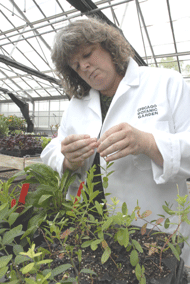
Dr. Kay Havens of the Chicago Botanic Garden. Havens leads a team of over 200 scientists, research associates, graduate and undergraduate students who are making vital discoveries about plant survival, habitat destruction, invasive species and restoration. (Courtesy of Chicago Botanic Garden)
CURWOOD: [LAUGHS] So what’s your favorite flower or vegetable for that matter that you grow in your garden and how has its blooming pattern changed over the years?
HAVENS: Oh gosh, that’s a tough one. I did submit data on Dogtooth Violet and Bluebells last year - out of my own garden - two of my favorite little native spring wildflowers. And I have noticed over the years the springs are coming earlier and getting warmer and those plants are blooming earlier.
CURWOOD: Dr. Kay Havens is the director of plant science and conservation at the Chicago Botanic Garden. Which helps run the website Project BudBurst.
Thank you so much Dr. Havens.
HAVENS: Thank you and enjoy spring!
CURWOOD: I will a little bit sooner then I would have last year.
HAVENS: Yeah. [LAUGHS]
CURWOOD: And you can find a link to Project BudBurst through the Living on Earth website www.loe.org.
Links
Living on Earth wants to hear from you!
Living on Earth
62 Calef Highway, Suite 212
Lee, NH 03861
Telephone: 617-287-4121
E-mail: comments@loe.org
Newsletter [Click here]
Donate to Living on Earth!
Living on Earth is an independent media program and relies entirely on contributions from listeners and institutions supporting public service. Please donate now to preserve an independent environmental voice.
NewsletterLiving on Earth offers a weekly delivery of the show's rundown to your mailbox. Sign up for our newsletter today!
 Sailors For The Sea: Be the change you want to sea.
Sailors For The Sea: Be the change you want to sea.
 The Grantham Foundation for the Protection of the Environment: Committed to protecting and improving the health of the global environment.
The Grantham Foundation for the Protection of the Environment: Committed to protecting and improving the health of the global environment.
 Contribute to Living on Earth and receive, as our gift to you, an archival print of one of Mark Seth Lender's extraordinary wildlife photographs. Follow the link to see Mark's current collection of photographs.
Contribute to Living on Earth and receive, as our gift to you, an archival print of one of Mark Seth Lender's extraordinary wildlife photographs. Follow the link to see Mark's current collection of photographs.
 Buy a signed copy of Mark Seth Lender's book Smeagull the Seagull & support Living on Earth
Buy a signed copy of Mark Seth Lender's book Smeagull the Seagull & support Living on Earth

